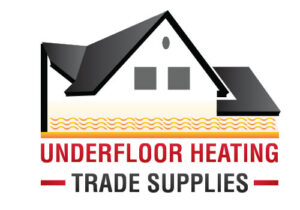Are you preparing for an underfloor heating project?
Look no further, as this article will guide you through choosing the best adhesive for underfloor heating, including the varieties of adhesives, and which ones are suitable for both electric and water-based underfloor heating systems.
- Understanding Underfloor Heating
- Preparing for Installation
- Understanding Your Adhesives
- Adhesive Labelling and Coding
- Adhesives for Electric Underfloor Heating Systems
- Adhesives for Water Underfloor Heating Systems
- Adhesives for Floor Coverings
- Pros and Cons of Using Adhesive
- Pros of adhesive on underfloor heating
- Cons of Adhesive for Underfloor Heating
- Choose the Best Adhesive for Underfloor Heating
- FAQs
- Sources
Understanding Underfloor Heating
So, before we consider the best adhesive for underfloor heating, are you aware of the types of underfloor heating that are available on the market, and what benefits they can bring to your home or establishment?
- Hydronic underfloor heating: Hydronic underfloor heating, also known as water-based underfloor heating, involves circulating warm water through a network of pipes installed beneath the floor. A boiler or heat pump heats the water, which is then distributed through the pipes to provide consistent and comfortable heat throughout the space. The heat radiates from the floor, warming the room from the ground up, creating a pleasant and efficient heating system.
- Electric underfloor heating: Electric underfloor heating operates by utilising a network of electric heating cables or mats installed beneath the floor surface. These heating elements generate heat when an electric current passes through them. The system is controlled by a thermostat, allowing users to regulate the temperature in individual rooms. Electric underfloor heating offers quick and responsive heating, making it suitable for smaller areas or specific zones within a home or building.
Because of the different types of underfloor heating, each system requires different tile adhesives. If the adhesive instructions are not followed correctly, it can affect the performance of the floor installation and therefore falter the performance of the underfloor heating. Make sure to choose whether electric or water underfloor heating is right for you before selecting your adhesive.
Purchase our self-levelling floor compounds for efficient adhesive results.
Preparing for Installation
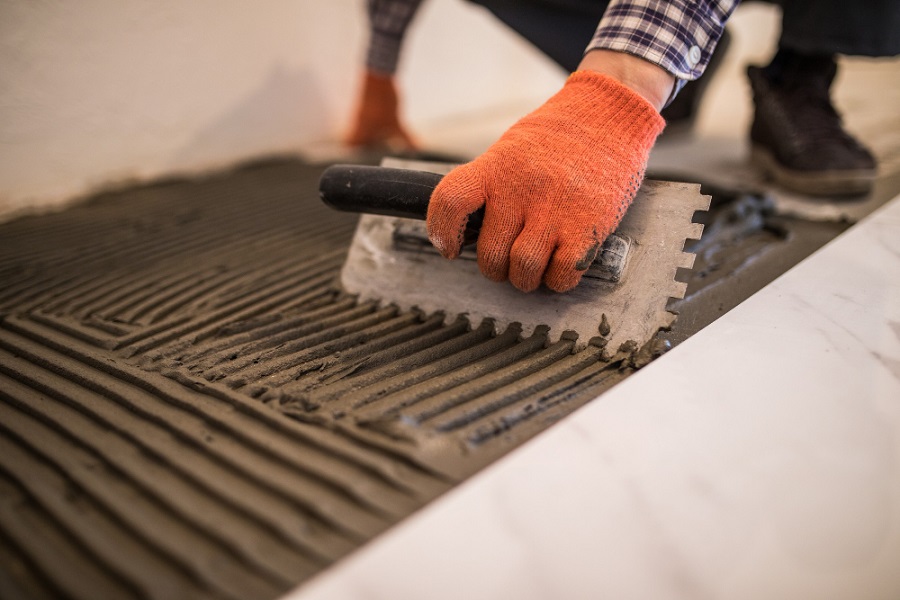
Get your project off to a strong start by selecting the perfect materials tailored to your specifications. Quality materials mean dependable results. Consider the following:
- Project specifications: what materials will you need? What flooring will the underfloor heating system be applied to? Make sure to ask yourself these questions and more to ensure the project runs smoothly.
- Compliance with European Standards[i]: Ensure purchased materials are tested and backed by warranties and comply with regulations set by the European Standards, to guarantee a reliable system setup.
- Follow instructions: Stick to the manufacturer’s installation manuals, including adhesive mixing and system installation guidelines. Previous experience doesn’t replace adherence to specific instructions. Remember, warranties may be void if instructions are discarded.
Understanding Your Adhesives
In simple terms, adhesive for underfloor heating is a specialised type of adhesive designed to securely bond the subfloor in conjunction with an underfloor heating system. It is built to withstand the high temperatures generated by the heating elements and maintain a strong bond even under thermal expansion and contraction. This adhesive provides excellent adhesion properties, flexibility, and durability, ensuring that the tiles remain securely in place while allowing the heat to transfer efficiently from the heating system to the floor surface.
European Standards for Adhesives
Next, we need to observe the quality you should expect from an adhesive before making a purchase. Irrespective of your project, the adhesive should have undertaken tests that conform to the European Standards for you to feel confident with your choice. This is because the tests will measure the level of polymer in an adhesive. The higher the level of polymer, the better the adhesive will perform in areas of temperature change – such as turning the heating on and off.
Adhesives that do not perform well under European Standards have a stronger likelihood of failing when used with underfloor heating.
The European Standards test the bond strength of an adhesive at 70°C which is fundamental for an adhesive for floor heating. The bond strength is usually tested in:
- Dry conditions
- Underwater (known as wet storage)
- Freeze/thaw conditions.
Adhesive Labelling and Coding
When choosing the best adhesive for underfloor heating, you might encounter cryptic codes on packaging or websites. These codes contain vital information about the adhesive’s performance in the aforementioned tests. Familiarise yourself with these codes to make informed purchases.
Here’s what each adhesive label[ii] and code represents:
- C2 = Enhanced Cementitious Adhesive
- F = Rapid Setting
- T = Reduced Slip
- E = Extended Open Time
- S1 = Flexible Adhesive
- S2 = Highly Flexible Adhesive
Now, let’s consider crucial factors for adhesive selection:
- Subfloor: Determine if your subfloor is solid (concrete) or wooden, as certain adhesives are specific to each flooring.
- Underfloor Heating System: The type of underfloor heating system that you choose will also influences your adhesive choice. Keep this in mind when making your selection and consider the advantages of underfloor heating.
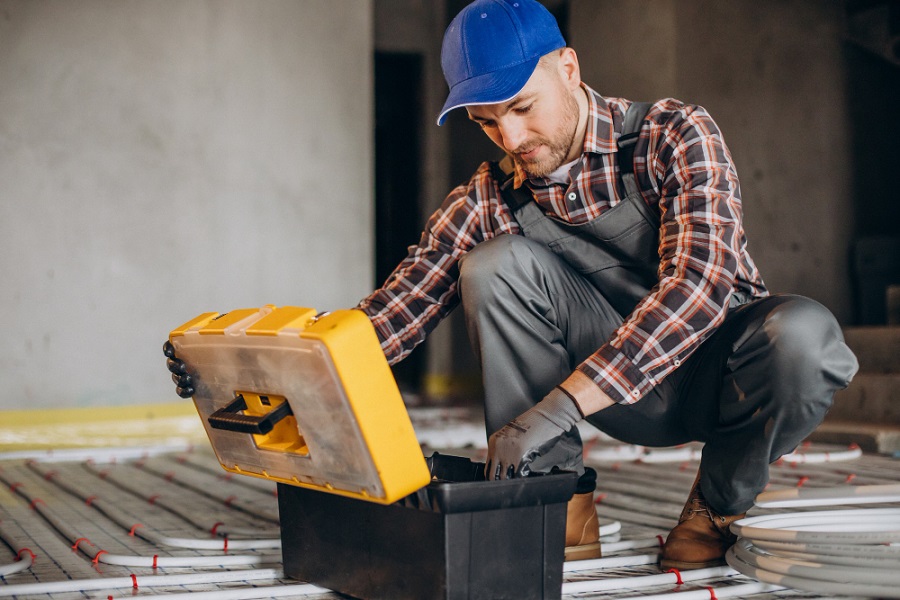
Adhesives for Electric Underfloor Heating Systems
Electric underfloor heating systems offer two options: loose electric heating cables (loose wire) or cables within mats. For an even heat distribution, installers manually space the loose wire, while mats have pre-spaced cables, like our low profile insulation mats or our 18mm solid-floor tile direct system, made to be compatible with most modern boilers.
High-polymer adhesives excel with underfloor heating, and can stabilise with temperature changes. Our self-levelling adhesives comply with European Standards, but different systems demand specific options. In screed systems such as our heatdeck 18 lowlay gypsum screed boards while close-to-subfloor systems require flexibility and high polymer levels.
Our flooring adhesives are the best product on the market for a smooth underlayment of your underfloor heating. Please also note that some underfloor heating adhesives may work better or are more compatible than others, which we will also go into more detail about. Our tile adhesives are compatible with electric underfloor heating systems including loose wire and matted systems, and can also achieve efficient results on wooden subfloors.
Adhesives for Water Underfloor Heating Systems
Water underfloor heating systems, unlike electric systems, utilise heated water instead of metal wires. This structural difference results in larger water floor heating systems that require more space compared to electric systems. Consequently, most hydronic systems necessitate more flexible tile adhesive. However, the adhesive properties required for both water and electric systems remain the same: high polymer content to handle temperature changes and flexibility to accommodate sub-floor movement without damaging the floor surface. While many of our adhesives work for both systems, caution is advised to ensure optimal results.
For the advanced water system, a 16mm dual-purpose overlay panel serves as both insulation and a holder for water pipes. Its compact design makes it heavier and less flexible than plastic mats or pre-moulded retention clips. Thus, a high-quality flexible tile adhesive is recommended to ensure unmatched deformability, durability, and resilience to temperature changes.
Conversely, we advise against using entry-level adhesives for wet underfloor heating systems due to their limited flexibility compared to electric systems.
Adhesives for Floor Coverings
Most floor coverings available on the market can be applied to underfloor heating. However, this does not necessarily answer as to what is the best adhesive for underfloor heating. What differentiates floor coverings is that the materials that they are constructed with conduct thermal activity, meaning that they can work quickly and effectively to transfer heat across the flooring.
Tile, Stone & Polished Concrete
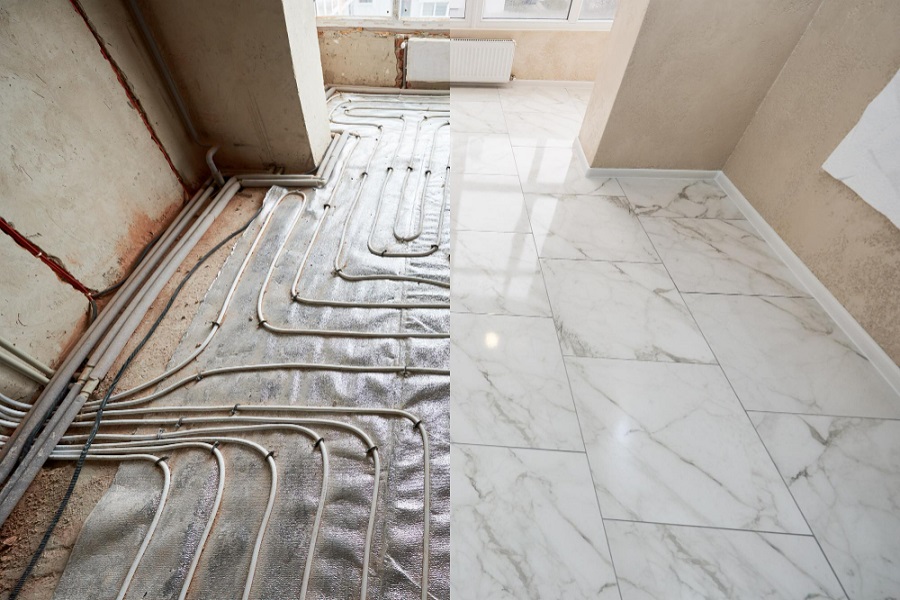
Tile, stone, and polished concrete/screed are the optimal choices for floor coverings when using underfloor heating. These surfaces possess high thermal conductivity, ensuring efficient heat transfer from the heating system. However, screed can take a long time to dry, so make sure to be aware of how long screed takes to dry.
Additionally, these forms of flooring retain heat effectively, maximising the system’s efficiency. While the thickness of the covering has minimal impact on heat output, it does affect heat-up times.
When installing underfloor heating beneath tile, stone, or uncoated insulated eco-board, it is crucial to use a high-quality flexible cement-based adhesive. This ensures optimal performance of the heating system on a concrete slab.
Find out how to install underfloor heating on concrete floors.
Engineered Timber
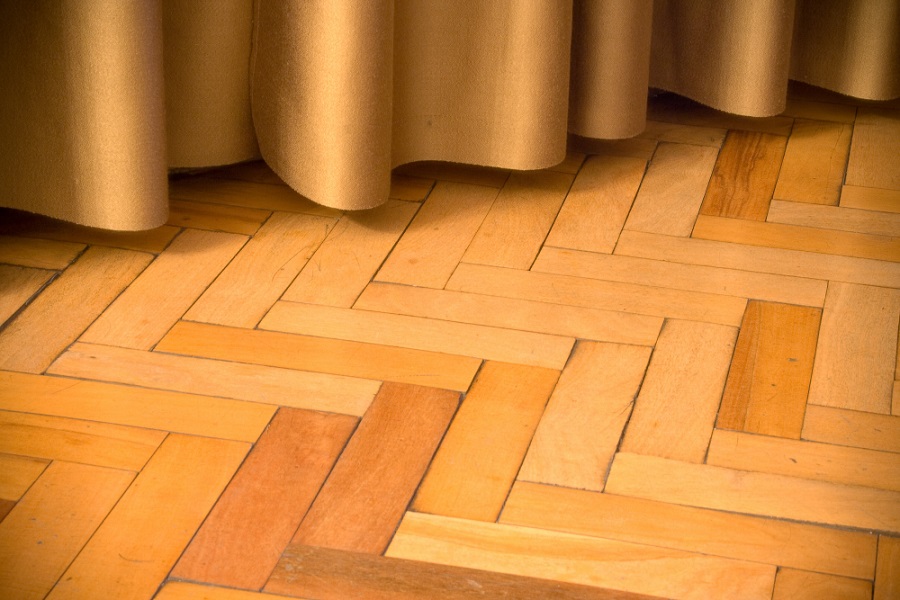
Incorporating engineered timber as a flooring finish with underfloor heating on timber floors is also highly recommended. Engineered timber exhibits excellent performance when it comes to fluctuating floor temperatures and adapting to varying moisture levels. However, it is crucial to consult the manufacturer to ensure its compatibility and suitability for use with underfloor heating. Follow the manufacturer’s guidelines before proceeding and you can achieve great results from using the best tile adhesive for underfloor heating.
Solid Hardwood
Solid hardwood flooring can be susceptible to humidity and changes in temperature which can lead to it gapping and crowning. When purchasing your underfloor heating systems and self-levelling adhesive, make sure to consult our team to see whether it will be compatible with this style of flooring if you have it in your home.
Learn more about the differences between engineered hardwood vs solid flooring[iii] for optimum results.
Softwood Flooring
Softwood is another type of flooring that is compatible with underfloor heating and suitable underfloor heating adhesive. Again, the quality can be affected by the floorboard thickness which should be no thicker than 20mm; this is to ensure enough heat is distributed evenly. To ensure that your project does not go wrong, learn how to retrofit underfloor heating if you are adding an underfloor heating system to an already-built home.
Bamboo and Hybrid
Bamboo and hybrid flooring share similarities with engineered wood, making them favourable choices for underfloor heating due to their effective heat conduction. They are well-suited to work in conjunction with underfloor heating systems. However, check that they are safe to use with underfloor heating by consulting the manufacturer.
Adhesives
To ensure proper installation, choose a high-quality flexible cement-based flooring adhesive when laying the floor finish directly over the heating system. Another option is to apply a self-levelling layer over the heating, followed by laying the floor finish on top of it.
Pros of adhesive on underfloor heating
The longevity of your tile flooring can be influenced by the specific areas where they are installed. High-traffic zones like kitchens and bathrooms put increased strain on the tiles. When combined with underfloor heating, select an adhesive that can withstand such stress and extend the lifespan of the tiles.
Tile adhesives are typically rated as S1 or S2, with S2 being recommended for high-traffic areas and the added consideration of underfloor heating. S2 adhesive is essential to safeguard the flooring from potential cracks caused by temperature fluctuations.
Colour
Powdered adhesives tend to come in grey or white formats. White glue adhesive is better applied for light grout flooring. The opposite can be applied to darker grouts.
Setting Period
When it comes to tile adhesive, you have the option to choose between rapid or standard-setting variants, each with its own advantages. Rapid setting adhesive is favoured by professionals due to its time-saving properties, especially for large-scale projects.
On the other hand, standard-setting adhesive offers a longer setting time, allowing for precise tile placement, making it ideal for intricate patterns or smaller tiles.
Cons of Adhesive for Underfloor Heating
Here are the drawbacks to consider when choosing the best adhesive for underfloor heating:
Compatibility Concerns
Not all adhesives are suitable for use with underfloor heating systems. It’s crucial to ensure that the adhesive you choose is specifically designed and approved for this purpose to avoid performance issues or potential damage.
Thermal Expansion
Underfloor heating involves significant temperature fluctuations, which can cause materials to expand and contract. If the adhesive lacks sufficient flexibility or does not have a high polymer content, it may struggle to accommodate these movements, leading to tile cracking or adhesive failure over time.
Installation Time Constraints
Some adhesives, especially rapid-setting ones, require quick and precise installation due to their fast-drying nature. This can pose challenges for novice tilers or when working on complex projects, as it leaves less room for adjustments and tile positioning.
Cost
Adhesives specifically formulated for underfloor heating may be pricier compared to standard adhesives. While investing in a high-quality adhesive is essential for the longevity and performance of your underfloor heating system
Choose the Best Adhesive for Underfloor Heating
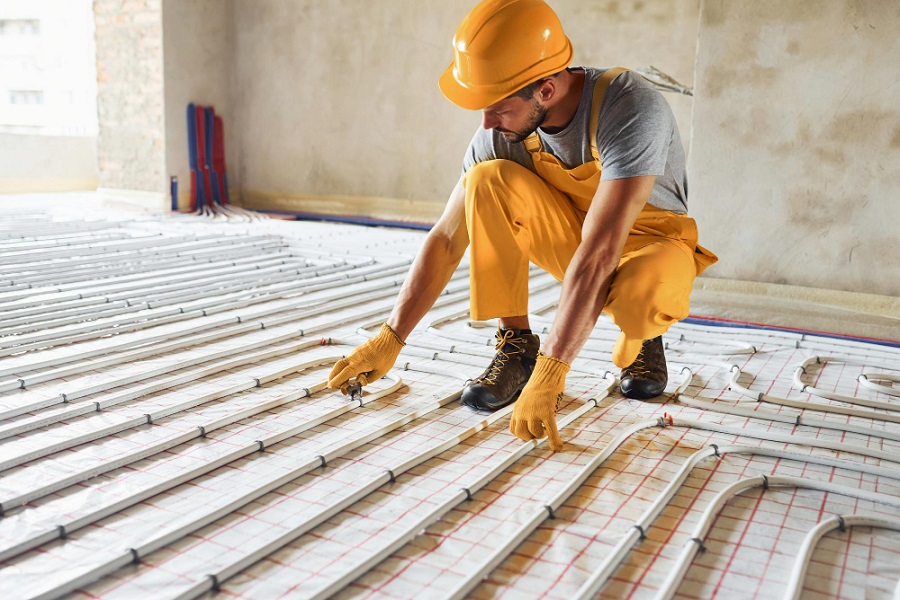
In conclusion, when selecting a flexible tile adhesive for your floor heating project, ensure that the adhesive is compliant with European Standards and that you are using the adhesive on the right flooring. Opt for an adhesive with a higher polymer level to handle temperature changes effectively and choose one that is highly flexible to accommodate sub-floor movement. If you have invested in a top-of-the-range radiant heating system, pair it with a high-quality adhesive to maximise performance.
FAQs
What type of adhesive should I use for underfloor heating?
When it comes to underfloor heating, it is crucial to use a flexible adhesive specifically designed for this purpose. Look for adhesives labeled as “underfloor heating adhesive” or “flexible tile adhesive.” These adhesives have properties that allow them to withstand the expansion and contraction associated with underfloor heating systems.
Can I use regular tile adhesive for underfloor heating?
It is generally recommended to avoid using regular tile adhesive for underfloor heating. Regular tile adhesives may not have the necessary flexibility to accommodate the movements of the underfloor heating system. Using a specialized underfloor heating adhesive ensures a secure bond and minimizes the risk of tile cracking or adhesive failure.
How do I apply adhesive for underfloor heating?
The application process may vary depending on the specific adhesive product. However, in general, the following steps apply:
Ensure that the subfloor is clean, dry, and free from dust or debris.
Mix the adhesive according to the manufacturer’s instructions, using the appropriate amount of water.
Apply the adhesive to the subfloor using a notched trowel, spreading it evenly and at the recommended thickness.
Place the heating elements or mats on top of the adhesive, following the manufacturer’s guidelines.
If necessary, embed the elements or mats into the adhesive by lightly pressing them down.
Allow the adhesive to cure for the recommended time before proceeding with the next steps, such as tiling or flooring installation.
Can I apply adhesive directly to the underfloor heating mats or cables?
It is generally not recommended to apply adhesive directly to the underfloor heating mats or cables. Doing so may interfere with the even distribution of heat and could potentially damage the heating elements. Instead, the adhesive should be applied to the subfloor, and the heating elements should be laid on top of the adhesive.
How long does the adhesive take to dry before tiling or flooring installation?
The drying time of the adhesive can vary depending on factors such as humidity, temperature, and the specific adhesive product used. Refer to the manufacturer’s instructions for the recommended drying or curing time. Typically, it can take anywhere from 24 to 48 hours for the adhesive to fully dry and be ready for tiling or flooring installation.
Can I use self-levelling compound with underfloor heating?
Yes, self-levelling compound can be used in conjunction with underfloor heating. Self-levelling compounds help create a smooth and level surface on top of the heating elements or mats. However, it is essential to check that the self-levelling compound you choose is compatible with underfloor heating systems and can withstand the temperature fluctuations.
Sources
[i] European Commission. (n.d.). European Standards. [online] Retrieved from: https://single-market-economy.ec.europa.eu/single-market/european-standards_en [accessed 23/06/23]
[ii] Weber. (2023) Adhesive Labels. [online] Retrieved from: https://www.weber-marking.com/glossary/adhesive-labels.html). [accessed 23/06/23]
[iii] Wallender, L., (2022) Engineered Wood vs. Solid Wood Flooring Comparison Guide. The Spruce. [online] Received from: https://www.thespruce.com/engineered-hardwood-vs-solid-flooring-1821677 [accessed 23/06/23]
